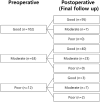Comparison of sensory outcomes in patients with successful motor outcome versus recurrent exotropia after surgery for intermittent exotropia
- PMID: 35915206
- PMCID: PMC9343388
- DOI: 10.1038/s41598-022-17067-5
Comparison of sensory outcomes in patients with successful motor outcome versus recurrent exotropia after surgery for intermittent exotropia
Abstract
Here, we compared sensory outcomes between patients with successful motor outcomes and recurrent exotropia after intermittent exotropia surgery. We retrospectively analyzed 303 patients who underwent surgery for intermittent exotropia, divided into two groups: successful motor outcome defined as an alignment between 10 prism diopters (PD) exodeviation and 5PD esodeviation at the final follow-up (Group A, n = 177) and residual or recurrent exotropia defined as exodeviation > 10 PD (Group B, n = 126). Preoperative and postoperative (at final visit) sensory outcomes were compared using the Titmus stereotest and distance Worth 4-dot test. Stereoacuity significantly improved postoperatively in both successful motor outcome group (Group A) and residual or recurrent exotropia group (Group B). However, stereoacuity did not differ between groups preoperatively and postoperatively. On the other hand, fusion rates for the Worth 4-dot test were significantly higher in group A than in group B, preoperatively and postoperatively, and significantly increased postoperatively only in group A. Therefore, the distance Worth 4-dot test may be useful for evaluating postoperative prognosis and preoperative sensory status.
© 2022. The Author(s).
Conflict of interest statement
The authors declare no competing interests.
Figures
Similar articles
-
Recovery From Suppression With Successful Motor Alignment After Surgery for Intermittent Exotropia.J Pediatr Ophthalmol Strabismus. 2020 Jan 1;57(1):21-26. doi: 10.3928/01913913-20191016-03. J Pediatr Ophthalmol Strabismus. 2020. PMID: 31972036
-
Assessment of central and peripheral fusion and near and distance stereoacuity in intermittent exotropic patients before and after strabismus surgery.Am J Ophthalmol. 1999 Aug;128(2):222-30. doi: 10.1016/s0002-9394(99)00079-3. Am J Ophthalmol. 1999. PMID: 10458180 Clinical Trial.
-
Characteristics of Patients Who Are Not Responsive to Alternate Patching for Overcorrected Intermittent Exotropia.Korean J Ophthalmol. 2018 Aug;32(4):319-327. doi: 10.3341/kjo.2017.0086. Korean J Ophthalmol. 2018. PMID: 30091311 Free PMC article.
-
Long-term Surgical Outcomes of Initial Postoperative Overcorrection in Adults with Intermittent Exotropia.Korean J Ophthalmol. 2018 Jun;32(3):228-233. doi: 10.3341/kjo.2017.0064. Epub 2018 May 15. Korean J Ophthalmol. 2018. PMID: 29770641 Free PMC article.
-
The subjective controllability of exotropia and its effect on surgical outcomes in patients with intermittent exotropia.BMC Ophthalmol. 2023 Mar 28;23(1):125. doi: 10.1186/s12886-023-02873-w. BMC Ophthalmol. 2023. PMID: 36978009 Free PMC article. Review.
Cited by
-
The association between stereoscopic vision and cognitive function on community-dwelling older adults: a cross-sectional study.BMC Geriatr. 2025 May 20;25(1):359. doi: 10.1186/s12877-025-06014-4. BMC Geriatr. 2025. PMID: 40394479 Free PMC article.
-
Sensory outcome of exotropia surgery in Thailand: a retrospective multicenter study.Int J Ophthalmol. 2025 Feb 18;18(2):330-339. doi: 10.18240/ijo.2025.02.18. eCollection 2025. Int J Ophthalmol. 2025. PMID: 39967977 Free PMC article.
-
Efficacy of part-time patching in preventing recurrence after bilateral lateral rectus recession in children with intermittent exotropia.BMC Ophthalmol. 2023 Dec 14;23(1):510. doi: 10.1186/s12886-023-03259-8. BMC Ophthalmol. 2023. PMID: 38098018 Free PMC article.
-
Effectiveness of Strabismus Surgery in Intermittent Exotropia and Factors Influencing Outcome.J Clin Med. 2024 Feb 11;13(4):1031. doi: 10.3390/jcm13041031. J Clin Med. 2024. PMID: 38398344 Free PMC article.
References
-
- Hardy LH. A modification of the 4-dot test. Am. Acad. Ophthalmol. Otolaryngol. 1937;30:491–492.
MeSH terms
LinkOut - more resources
Full Text Sources



